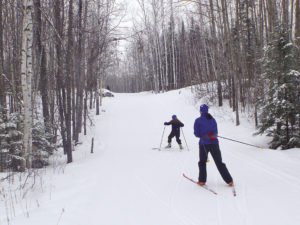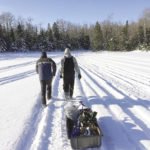You’re up here in the Northern Wilds, pacing a circle into the carpet indoors in the wintertime. You finally decide you’re going to give cross-country skiing a try. Good for you! It’s simply the greatest sport in the world. But skiing outdoors in the winter can be daunting for an absolute beginner. You’re in luck. This article will tackle the basics for a complete novice skier.
I’m not a professional, but I’ve been cross-country skiing since I could walk. I’ve finished the American Birkebeiner 50k ski race 13 times. I was a volunteer coach for the KidSki and ParentSki programs at Snowflake Nordic Center in Duluth. I’ve tried to boil what I know down to four topics.
- Visit your local ski shop. The experts at your local shop have the answers to all your questions. They’ll help you figure out what kind of cross-country skiing interests you. Do you want to bash through the woods? Are you mostly interested in getting exercise? Do you have your eye on a local groomed trail? Have a good talk about your goals with a sales representative and they will steer you in the right direction. That leads to the next item.
- Get good gear. This means skis, bindings, boots, poles and clothing. Once again, I recommend getting this stuff new at your local shop. Modern ski gear is good quality, even at the entry level. You can buy a package with all you need for a reasonable price. It does require a leap to make this investment. But, in my opinion, it’s worth it.
- At this point, you may need to make a choice between classic style and freestyle cross-country skiing (also called “skating”). Your choice will determine some of your equipment choices. I recommend you start out classic style. That’s the type of skiing that takes place in two tracks and what you probably picture when you think of the sport. We taught kids classic style first at the KidSki program. The balance and gliding you learn in classic will transfer to freestyle. This is a confusing topic for newbies and your shop can help you decide what’s right for you. This whole discussion of technique leads to the next point.
- Get Lessons. Your local shop can point you to ski instructors. Your local ski club may offer free technique sessions. For example, the Duluth Cross-Country Ski Club has offered free technique sessions in the past. You may ask, “Can’t I figure it out myself?” Maybe. But it could take many years and by the time you figure it out, you may have lost interest. A good instructor will give you enough information in one afternoon to chew on for a whole winter. You can improve more in one week with an instructor than you could in several winters by yourself. Adults seem reluctant to take lessons. Try to be like a kid. They’re sponges and they get better quick with coaching.

But don’t take it from me. I asked Mick Dodds, buyer and Nordic department manager for The Ski Hut in Duluth what his three pieces of advice were. He makes a living helping people get into the sport. His answers focus primarily on the first two points I made above:
“1. Think about where you want to ski and how you want to ski there. Groomed trails, no trail at all, lakes? Even a combination of any of these. There are different skis, boots, poles, and bindings to suit different experiences.
“2. Be open-minded. In today’s age of online researching there is a lot of misinformation out there. Don’t get stuck on having to have a certain ski. There may be better options that you don’t know about. Also, your racer friend may know what works for them, but they don’t necessarily know what works for you. A good shop wants to sell you what will make you happiest. Because happy customers come back!
“3. Don’t forget about what to wear cross-country skiing! It’s not just about the skis. If you get sweaty and cold you will likely not be having a lot of fun. Your skiing clothes make a HUGE difference in how enjoyable your time on skis will be.”
For a beginning cross-country skier, all of this can seem overwhelming. Don’t worry. Try to remember, this is supposed to be fun. If it’s fun, you’ll do it more. The friendly skiers at your shop, your good gear, and the instructor at your lesson are all on your side. We all want to see your big smile as you stride and glide over the snow in the Northern Wilds.




